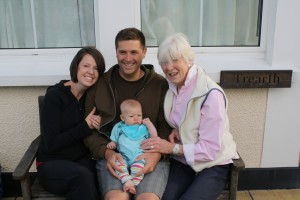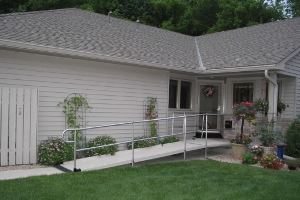Home Sweet Home: Making Home More Enjoyable for the Golden Years
 According to AARP, 89% of Americans want to stay in their current home as long as they can. Over the next 20 years, the Boomer Generation will start to look at their ho using options, and the prospect of going to live in a nursing home is not on their radar screen.
According to AARP, 89% of Americans want to stay in their current home as long as they can. Over the next 20 years, the Boomer Generation will start to look at their ho using options, and the prospect of going to live in a nursing home is not on their radar screen.
There’s a growing movement called “Aging in Place.” It means remaining in one’s home safely and independently for as long as possible, and this usually requires making modifications to the home.
Some of the most common modifications are made to combat fading eyesight and restrictions of movement, one of the main goals being to reduce the risk of injury due to a fall, not to mention making everyday tasks more convenient. With the baby boomer population of nearly 80 million consumers ages 45+, the availability of products and technology to meet this new demand is rapidly growing too. The National Association of Home Builders (NAHB) has developed programs that go well beyond the Americans with Disabilities Act for public facilities and is training and certifying specialists to incorporate solutions into new design and home modifications. The certification is called “CAPS” (Certified Aging-in-Place Specialist).
A Certified Aging-in-Place Specialist can provide valuable information about new trends, what’s worked for others, and manage or provide the installation that you may want to implement when taking care of elderly parents. Some modifications a Certified Aging-in-Place Specialist may recommend to seniors and their families include:
In all areas, consolidate storage space so that what you need is more easily at hand. You would not want to risk getting up on an unstable step-ladder or chair to reach something when you don’t have to.
 The bath area should be looked at closely. Use slip resistant flooring; add grab bars to ease entry into and out of the tub/shower and around the toilet area. Use anti-scald pressure balanced faucets. If you are currently able to enjoy a nice relaxing soak, you most likely will want to continue that luxury so you may want to consider installing a walk-in tub with a low threshold entry that can double as a shower. The health benefits of hydrotherapy both physically and psychologically are well established. New studies show bathing before going to bed can help sleep patterns too. When possible, use a shower with a barrier-free entry.
The bath area should be looked at closely. Use slip resistant flooring; add grab bars to ease entry into and out of the tub/shower and around the toilet area. Use anti-scald pressure balanced faucets. If you are currently able to enjoy a nice relaxing soak, you most likely will want to continue that luxury so you may want to consider installing a walk-in tub with a low threshold entry that can double as a shower. The health benefits of hydrotherapy both physically and psychologically are well established. New studies show bathing before going to bed can help sleep patterns too. When possible, use a shower with a barrier-free entry.
In the kitchen, change out the sink fixtures with a single handle control, and use handles on cabinets as opposed to knobs. Choose counter tops with a darker color if you have visibility issues. Change fixed shelves in cabinets to pull-out shelves. Consider new appliances designed to pull out too.
 Add motion-activated lights both inside and outside the home—outside main entry points to your home or places where your hands may be full and where you can’t reach a light switch easily. Illuminate your steps. Add inexpensive LED motion activated nightlights thro ughout the home—especially in high traffic areas, and in your bedroom and on the pathway to your bathroom.
Add motion-activated lights both inside and outside the home—outside main entry points to your home or places where your hands may be full and where you can’t reach a light switch easily. Illuminate your steps. Add inexpensive LED motion activated nightlights thro ughout the home—especially in high traffic areas, and in your bedroom and on the pathway to your bathroom.
Properly designed and installed, all these modifications can enhance safety, functionality, curb-appeal, the value of your home, and maybe most importantly—your continued enjoyment of your home.
Information provided by Jenny Kasbohm, co-owner of AgeRight Retrofit, Inc., a licensed and insured, Certificated Aging-in-Place Specialist remodeling company. www.agerightretrofit.com













